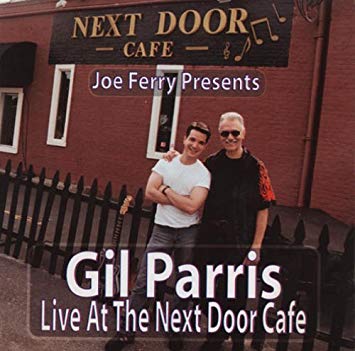
Gil Parris reminds me of a perfect, reversible wind-breaker -- one that looks great on both sides. Except this jacket would need four sides. Because Parris plays blues, jazz, funk, and country music. And the parka would have to be see-through since Parris loves to mix his idioms.
Upon first hearing that "Live At The Next Door Cafe" would be released in December 2004, I literally jumped out of my seat. For I had paid the five dollars to get into The Next Door Cafe in Stamford, Conn. on May 23, 2001. If I remember correctly, the money went to rent the mobile recording truck parked out back. Risky business -- record first, sell later. Parris and band (Joe Ferry on bass, Stuart Stahr on drums, Jeremy Baum on organ, Jim MacElwane on sax, and Steph Chinn on trumpet) would walk a tightrope that evening without a net. This CD captures songs from two sets recorded and mixed direct to tape. That means no overdubs or fixes. I can't find a "clam" on the album! I once asked Parris why he didn't play more slide guitar. He said he based his style on rhythmic patterns and that slide didn't really play to his strong suit. Indeed, the rhythm section separates this CD from previous solo Parris efforts. Joe Ferry on bass coupled with Stuart Stahr on drums lay down a very simple, but tight, rock-oriented groove. "Sister Sadie," written by Horace Silver, kicks off the album with an infectious, New Orleans funk groove. The melody and changes start simple enough, until Parris throws in his distorted pedal-steel-influenced bends, bluesy double-stops, and rapid-fire, staccato fills that sound like the pops you make by poking your index finger inside puffed-out cheeks. "Ain't No Sunshine" (Bill Withers) serves as Parris's signature tune -- make that his signifying tune. Parris playfully roots around his bag of tricks and slowly builds to an amazing climax worthy of Pink Floyd at its best. Then he dynamically backs out of the song with fiery, Flamenco riffs mixed with a touch of dissonance. A true show stopper. Seemingly out of nowhere, "Oblivion Express" appears (written by Parris and Joe Ferry) and takes us on a psycho journey through "Deliverance" territory. Picture, if you will, Chet Atkins and Danny Gatton on acid. Parris's "Hank & David" begins as an extremely rudimentary, mid-tempo, blues shuffle. Once again Parris unleashes slightly distorted pedal steel-riffs. Before long, the dissonance falls away to reveal a chicken-picking approach. Suddenly, Parris launches into full Albert King mode as the band locks in and drives it home. "Blue Thumb," the title track of Parris's 2002 traditional jazz release, stands out as the one straight "jazz" tune on the album. This tribute to Wes Montgomery, a rhumba, starts with the melody played octave style -- with his thumb, of course. Parris soon morphs into a more dynamic, single-picked, scalar style before returning to octaves. Patsy Cline, a favorite of Parris, inspired him to write "Ol' Soul. Beautiful, shimmering, rhythm guitar, drenched in reverb, opens the song. Parris's by now familiar, pedal-steel approach introduces the melody. Out of the blue, the tune modulates. Shockingly, it sounds like Parris actually hit a wrong note. The second time it happens, you realize that Parris doesn't make mistakes. Keyboardist Jeremy Baum grabs the spotlight with a tasty organ solo. Then Parris shifts into blues overdrive and guns the tune home. "Double Trouble" alludes to Parris's friends, bassist Chris Layton and drummer Tommy Shannon, who now tour as Double Trouble but used to back Johnny Winter and later, Stevie Ray Vaughan. This rocking blues serves simply as a blowing vehicle. Joe Ferry slyly changes the bass line for each verse, even once quoting "Wipe Out." Parris first flashes some lightning-fast, open-string, country blues pull-offs. Then he leans into some heavier pull-off patterns higher up the neck. Suddenly, he backs down and switches to a scale that features the major seventh and Hawaiian-style guitar. Jeremy then steps in and pumps out a throbbing organ solo. The album closes with an old crowd favorite, "Sex Machine." The boys give this funk classic a real thrashing. First up is a short burst from Jeremy Baum on organ. Second, a quick blast from Parris. He opens with cool, double octave intervals, then quickly fires up the rock tone and mixes in a little dissonance. Next up is a slow building, rhythmic alto solo by Jim MacElwane who peaks with squeals and howls. Jeremy lights up the organ for another supercharged round. They all head back to the bridge and end the song. I remember reviewing Jeff Beck's "Blow By Blow" album. As much as I loved Jeff, I didn't think the record would find an audience. Wrong! I recently saw Parris at an intimate Westchester club called "Watercolors." The keyboard player never showed up. A true gentleman, Parris worried more that the pianist might have crashed than that he was short a musician. At the bar, a gentleman in a spectacular white suit sat down next to me and introduced himself as a 68 year old guitarist who had just come off a general business gig. He had never heard of Gil Parris. One minute into Parris's first song, he screams, "The kid's a genius. What's wrong with this world. He should be playing the Garden!" Needless to say, Parris has found an audience. Hopefully, this record will do for him what "Blow By Blow" did for Jeff Beck. ©2004 Roger Zee